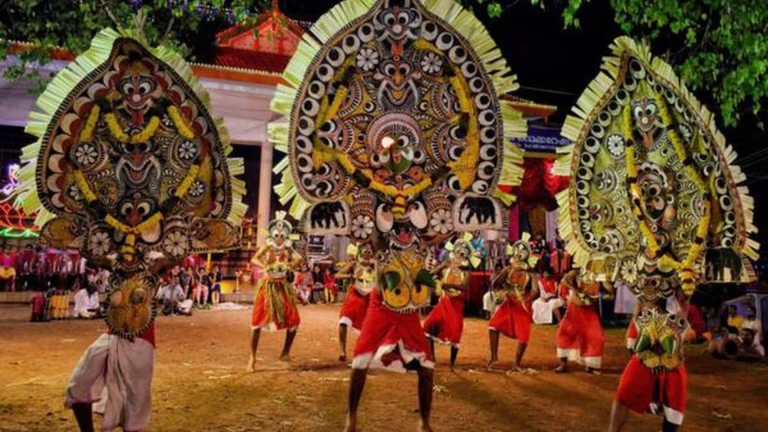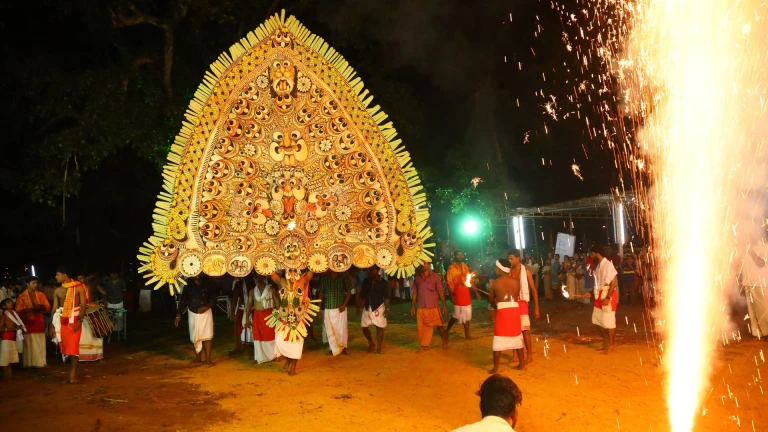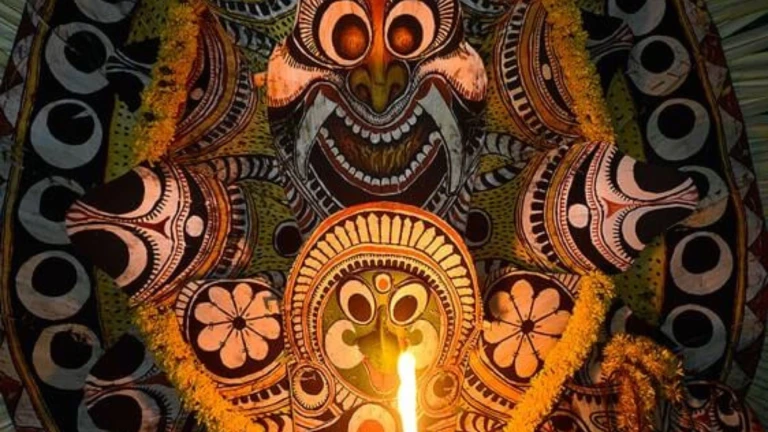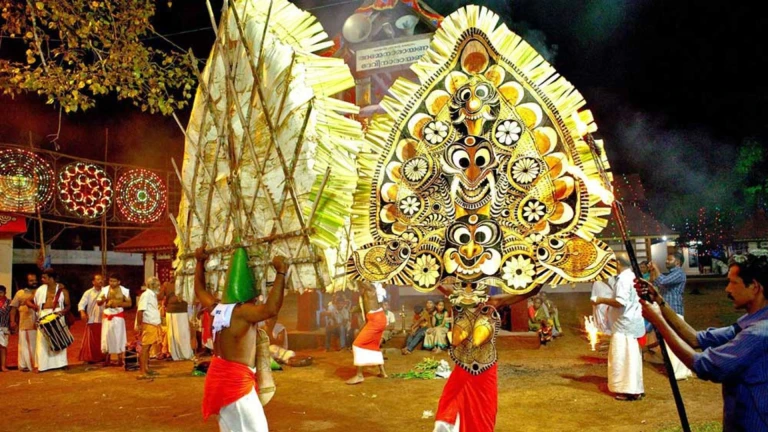Kadammanitta Padayani: A colorful festival in Kerala you should know about
Kerala, a land known for its serene backwaters, lush greenery, and rich culture, also boasts vibrant festivals that pulsate with life and tradition. One such spectacle, often overshadowed by its more famous counterparts, is the Kadammanitta Padayani. Held annually at the Kadammanitta Bhagavathy Temple in Pathanamthitta district, this ten-day extravaganza is a kaleidoscope of colors, captivating performances, and unwavering faith.
Also Read: 24 Hours in Kerala's Capital - Thiruvananthapuram
If you're looking for an off-the-beaten-path experience that dives deep into the soul of Kerala, the Kadammanitta Padayani is an unforgettable immersion. This blog post will be your guide to this unique festival, taking you through its history, rituals, and the dazzling art form that takes center stage - Padayani.

A Legacy Steeped in Tradition
The origins of the Kadammanitta Padayani remain shrouded in some mystery, but estimates place its existence centuries back. Legends say the festival commemorates the victory of Bhadrakali, a fierce form of the Goddess Durga, over a demon king. Another belief associates it with the appeasement of various deities and ancestral spirits. Regardless of its origin story, the Padayani festival has become an integral part of the cultural fabric of Kadammanitta, fostering a strong sense of community and religious harmony.
The Art of Padayani: Where Mythical Figures Come Alive
The heart and soul of the Kadammanitta Padayani lies in the captivating art form of Padayani itself. Padayani translates to "large figures" in Malayalam, and these figures are truly awe-inspiring. Local artisans meticulously craft gigantic masks, or "kolams" as they're called, using the dried stalks of the areca nut tree. These kolams depict various deities, mythical beings, and even animals, each boasting intricate details and vibrant colors.

Some of the most prominent kolams you'll encounter during the festival include:
Bhadrakali: The fiery goddess herself, often depicted with eight arms and a ferocious demeanor.
Kalan: The imposing God of Death, adorned with a skeletal visage and a reminder of life's impermanence.
Yakshi: Enchanting beings from local folklore, sometimes portrayed as benevolent and sometimes as mischievous.
Pakshi: Majestic birds, soaring high on bamboo poles, adding a touch of whimsy to the procession.
Kuthira: Powerful and spirited horses, a symbol of valor and strength.
The creation of these kolams is a painstaking process that takes weeks, if not months. Artisans meticulously shape the areca nut stalks, layer them with paper and cloth, and then comes the vibrant painting. Natural dyes and pigments are often used, bringing the mythological figures to life with stunning colors.
A Festival Unfolds: Witnessing the Magic
The Kadammanitta Padayani unfolds over ten days, each filled with unique rituals and performances. The festival traditionally begins with the 'Chottu Vappu,' a fire-lighting ceremony that purifies the temple premises and marks the commencement of the festivities.
As the days progress, the energy in the village reaches a crescendo. The colossal kolams are brought out, adorned with dazzling jewelry, intricate costumes, and elaborate headgears. Devotees carry these majestic figures on their shoulders, creating a mesmerizing spectacle. The rhythmic beating of drums and the chanting of prayers fill the air, further heightening the spiritual atmosphere.
One of the most captivating aspects of the festival is the 'Ezhunnallathu,' a vibrant procession that winds its way through the village streets. The colossal kolams, accompanied by costumed performers and traditional music, create a captivating spectacle. Devotees throng the streets, offering prayers and seeking blessings from the deities represented by the kolams.

Beyond the Spectacle: A Celebration of Community
The Kadammanitta Padayani is more than just a visual spectacle; it's a powerful display of community spirit and devotion. The meticulous preparation of the kolams, the tireless efforts of the performers, and the fervent participation of the devotees - all come together to create a unique tapestry of faith and cultural expression.
The festival also fosters a sense of social harmony. People from all walks of life, irrespective of caste or creed, come together to celebrate their shared heritage. The air vibrates with a sense of camaraderie and shared purpose, making the Kadammanitta Padayani a truly unifying experience.
Tips for Experiencing the Kadammanitta Padayani
The Kadammanitta Padayani is typically held between the 1st and 10th day of the Malayalam month of Medam, which usually falls in April. Here are some tips to ensure a memorable experience:
Accommodation: Kadammanitta is a small village, and accommodation options might be limited. Booking a stay in nearby Pathanamthitta or Alappuzha well in advance is recommended.
Respecting Traditions: Remember, the Kadammanitta Padayani is a religious festival. Dress modestly and be mindful of local customs. Seek permission before photographing devotees or the kolams.
Weather: Kerala experiences hot and humid weather during April. Carry light cotton clothes, sunscreen, and a hat.
Essentials: Pack comfortable walking shoes, water bottles, and cash as ATMs might be scarce in the village.

Beyond the Festival: Exploring Pathanamthitta
While the Kadammanitta Padayani is the star attraction, Pathanamthitta district offers a plethora of experiences for the curious traveler. Here are a few options:
Backwaters Bliss: Embark on a serene backwater cruise through the tranquil canals of Alleppey, a short drive from Kadammanitta.
Aranmula Parthasarathy Temple: Witness the unique offering of ghee (clarified butter) at this ancient temple, said to be a continuous tradition for centuries.
Explore the Beaches: Relax on the pristine beaches of Alappuzha, renowned for its laid-back charm and bohemian vibe.
Ayurvedic Rejuvenation: Immerse yourself in the ancient healing practice of Ayurveda at one of the many renowned Ayurvedic centers in the region.
Also Read: 10 Unique Things to Do Only in Kerala
A Festival that Stays With You
The Kadammanitta Padayani is more than just a vibrant display of colors and captivating performances. It's a window into the soul of Kerala, showcasing its rich artistic heritage, unwavering faith, and strong sense of community. Witnessing this unique festival is an experience that will stay with you long after the final drumbeat fades away.
So, if you're seeking an authentic and unforgettable encounter with Kerala's cultural tapestry, make sure the Kadammanitta Padayani finds its way onto your travel itinerary.
Published at
About Author
Manya Shastry
Subscribe our Newsletter
Get our weekly tips and travel news!
Related Posts
10 Best Countries to Celebrate New Year 2025
Explore the best countries to celebrate New Year 2025, from Sydney's dazzling fireworks to Rio's beach parties and Tokyo's traditional celebrations.
10 Best Places in India to Celebrate Ganesh Chaturthi 2024
Explore the 10 best places in India to celebrate Ganesh Chaturthi!
10 Most Popular Festivals in North India
Explore the vibrant tapestry of North India's festivals, from the dazzling lights of Diwali to the joyous hues of Holi, showcasing a rich cultural heritage that unites communities in celebration and harmony.
10 Unique Festivals of India that we bet you didn't know about
Journey through India's lesser-known festivals, from the vibrant Hornbill Festival in Nagaland to the tranquil Pongal celebrations in Tamil Nadu.
10 Ways to Make Valentine’s Day Extra Special in Mumbai
Celebrate Valentine’s Day in Mumbai with these 10 romantic experiences, from rooftop dinners to beach picnics, yacht rides, and more for a perfect date.
Latest Posts
You don't Need FASTag anymore? Everything you need to know!
No more FASTag from May 1st?
10 Dreamy Experiences for Couples in Kashmir
Fancy some romantic experiences in Kashmir?
How much will a trip to Indonesia cost from India? Travel Budget Guide
Need to budget a tropical getaway from India to Indonesia?
Indian Traveler's 7 Day Itinerary for Island Hopping in Indonesia
Your perfect Indonesian island getaway guide is here!
Best 4-Day Itinerary for Kashmir, India
Ready to fall in love with Kashmir in just four days?

